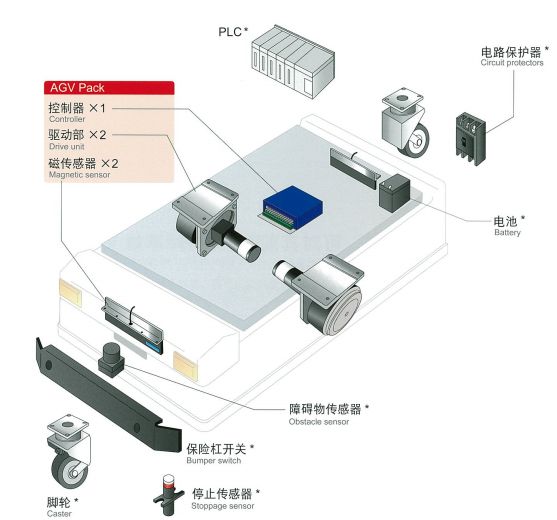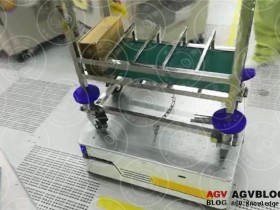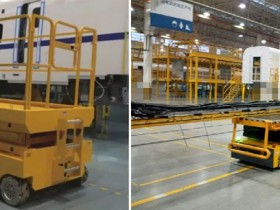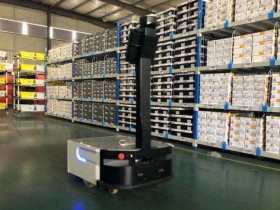Explanation of main parameters of AGV trolley
When we understand or purchase an AGV car, it is very important to be familiar with the main technical parameters of the AGV car. Many friends don't understand the meaning of the parameters very well. Here's how to combine this with your own products.
1. Guide method:
One of the key technologies of the AGV car is the navigation (guide) method. At present, there are mainly four types of electromagnetic induction, laser, vision and magnet guidance.
1) Electromagnetic induction guided
On the ground, a wire is buried along a predetermined travel path, in which a high-frequency current is passed, and an electromagnetic field is generated around the wire. The AGV follows the wire path by detecting the magnetic field. (The two electromagnetic sensors are symmetrically mounted on the left and right sides of the AGV, and the difference in the intensity of the electromagnetic signals they receive can reflect the extent to which the AGV deviates from the path.)
2) Laser guided
The AGV is equipped with a rotatable laser scanner, which scans the laser positioning mark (mounted on the wall or pillar along the running path, has a highly reflective reflector), receives the laser beam reflected by the positioning mark, and calculates the vehicle by the onboard computer. The current position and the direction of the movement are corrected by comparing with the built-in digital map.
3) Vision-guided
The AGV is equipped with a visual sensing device (CCD camera or visual sensor), and an image database of the environment surrounding the AGV scheduled travel path is provided in the on-board computer. During AGV driving, the camera dynamically acquires image information of the surrounding environment of the vehicle and compares it with the image database to determine the current location and make decisions for the next step.
4) Magnet – Gyro Guide
The special magnetic position sensor is used to detect the small magnet mounted on the ground, and then the gyroscope technology is used to continuously control the running direction of the unmanned vehicle.
2. Drive mode: The drive mode of the AGV car is divided into three drive types: SD-Steer Driving, DD-Differential Driving and QUAD (Quad Motion).
1) Single wheel drive
The driving wheel has both walking and steering functions, and the two driven wheels are fixed casters. When the stability is not enough, the movable casters can be added as auxiliary supports. The AGV trolley of this type of driving has a slightly poorer motion performance and a larger turning radius, but the guiding height is reliable.
2) Differential drive
The AGV symmetrically installs two drive wheels without steering, with two or more movable casters as the driven wheels, and relies on the differential speed of the left and right wheels to achieve steering. The AGV trolley in differential drive mode can realize all functions of single-wheel drive. The turning radius is small and the flexibility is good, but the wear of the driving wheel is serious due to the limitation of the differential mode.
3) Omnidirectional drive
With two driving wheels, both have walking and steering functions, and two or more movable casters are driven wheels. Generally, two driving wheels are installed at the front and rear ends of the AGV trolley. When the driving angles of the two driving wheels are the same, 2XSD mode motion can be realized when the direction is opposite (same as single wheel drive); parallel movement can be realized when the steering angles of the two drive wheels are the same, that is, the heading angle (attitude) of the AGV is unchanged; when the two drive wheels rotate 90 °, AGV car can be moved in differential mode, therefore, QUAD-type AGV is currently the most flexible, but due to the complexity of the mechanism, the control hardware cost and control difficulty will increase accordingly.
3. Rated load capacity (loading weight):
The maximum weight of the cargo that can be carried by the automated guided van. The load capacity of the AGV trolley ranges from 50kg to 20,000kg, mostly in small to medium tonnage. According to the survey conducted by the Ministry of International Trade and Industry of Japan, the current AGV small car weight is less than 100kg, accounting for 19%, the load weight is between 100kg and 300kg, 22%, 300kg-500kg, 9%, 500kg-1000kg, 18%, 1000kg~ 2000kg accounts for 21%, 2000kg-5000kg accounts for 8%, and 5000kg or more is rare.
4. Body size
The size of the AGV car body refers to the length, width and height of the car body. This size should be compatible with the size and channel width of the cargo being carried.
5. Driving speed
Refers to the maximum speed that can be achieved when the truck is automatically guided to travel under the rated load. It is an important parameter to determine the vehicle's operating cycle and handling efficiency.
6. Minimum turning radius
Refers to the distance between the instantaneous steering center and the longitudinal centerline of the AGV when the AGV trolley is running at low speed and at the maximum deflection. It is an important parameter to determine the space required for the vehicle to run in a curve
7. Positioning accuracy
Refers to the deviation value (mm) between the actual position where the AGV trolley arrives at the destination address and is ready for automatic transfer and the programmed position. This parameter is very important and is the main basis for determining the mode of transfer. Different transfer methods require different parking accuracy.
8. Continuous operation time
The automatic guided truck can continuously cycle for a working time when fully charged.
9. Security
In the cycle work, the AGV trolley encounters sudden failure or obstacle avoidance and processing capability. If the fault can automatically detect the fault, whether the obstacle is alarmed or avoid obstacles.





